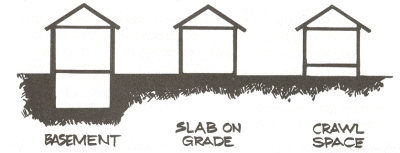Reducing Radon
There are several methods that can be used to lower Radon levels in your home. Your house type will affect the kinds of radon reduction systems that will work best. Houses are generally categorized according to their foundation design, such as:
-
• Basement
• Slab-on-Grade (Concrete poured at ground level)
• Crawlspace (A shallow unfinished space under the first floor)
Some houses have more than one foundation design feature. For instance, it is common to have a basement under part of the house and to have a slab-on-grade or crawlspace under the rest of the house. In these situations a combination of Radon reduction techniques may be needed to reduce high Radon levels.

Basement and Slab-on-Grade Houses
In homes that have a basement or a slab-on-grade foundation, Radon is usually reduced by one of three methods:
-
• subslab suction
• drain tile suction
• sump hole suction
Active Subslab Suction (also called active mitigation system) is the most common and usually the most reliable Radon reduction method. Suction pipes are inserted through the floor slab into the crushed rock or soil underneath. They also may be inserted below the concrete slab from outside the house. The number and location of suction pipes that are needed depends on how easily air can move in the crushed rock or soil under the slab, and on the strength of the Radon source. Acting like a vacuum cleaner, a fan connected to the pipes draws the Radon gas from below the house and then releases it into the outdoor air. Passive subslab suction is the same as active subslab suction except it relies on air currents instead of a fan to draw Radon up from below the house. Passive subslab suction is generally not as effective in reducing high Radon levels as active subslab suction.
Some houses have drain tiles to direct water away from the foundation of the house. Suction on these drain tiles is often effective in reducing Radon levels if the drain tiles form a complete loop around the foundation. One variation of subslab and drain tile suction is sump hole suction.
Often, when a house with a basement has a sump pump to remove unwanted water, the sump can be capped so that it can continue to drain water and serve as the location for a Radon suction pipe.
Crawlspace Houses
In houses with crawlspaces, high Radon levels can sometimes be lowered by ventilating the crawlspace passively (without the use of a fan) or actively (with the use of a fan). Crawlspace ventilation lowers indoor Radon levels both by reducing the home's suction on the soil and by diluting the Radon vents, or installing additional vents. Active ventilation uses a fan to blow air through the crawlspace instead of relying on natural air circulation. In colder climates, for either natural or active crawlspace ventilation, water pipes in the crawlspace need to be insulated against cold. Another effective method to reduce Radon levels in crawl space houses involves covering the earth floor with a heavy plastic sheet. A vent pipe and fan are used to draw the Radon from under the sheet and vent it to the outdoors. This form of soil suction is called submembrane depressurization. One other Radon reduction technique that can be used in any type of house is sealing. This method, however, is considered to be either a temporary measure or only a partial solution to be used in combination with other measures. Sealing cracks and other openings in the foundation is a basic part of most approaches to Radon reduction. Sealing does two things, it limits the flow of Radon into your home and it reduces the loss of conditioned air, thereby making the Radon reduction techniques more effective and cost-efficient. EPA does not recommend the use of sealing alone to reduce high Radon levels because, by itself, sealing has not been shown to lower Radon levels significantly or consistently. It is difficult to identify and permanently seal the places where Radon is entering. Normal settling of your house opens new entry routes and reopens old ones.
